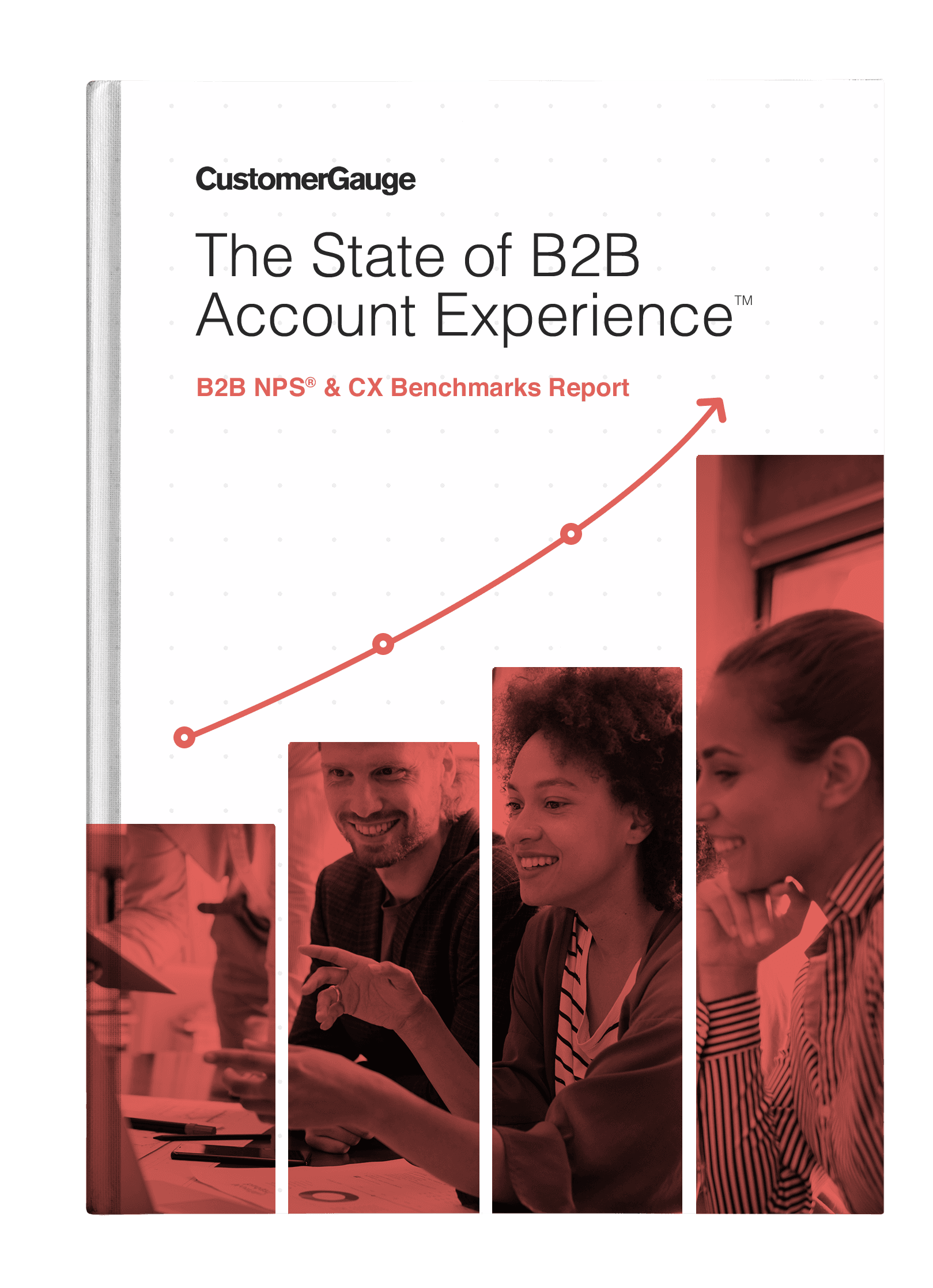38 SaaS NPS Benchmarks & Top SaaS eNPS scores
by Ian Luck
In SaaS, product and marketing should work in tandem to drive customer referrals.
Your referral and upsell stats are the ultimate test of sustained product value. They're the number one indicator of company health and future growth rate.
But, how does one get more referrals? And how can you identify opportunities for account growth? The answer lies in the Monetized Net Promoter methodology.
In this guide, we'll cover the essentials of Net Promoter in SaaS and rank NPS leaders in the SaaS sector (38 benchmarks from companies like Netflix, Google and Twilio!)
We'll then take a look at how your NPS program can go one step further than loyalty research. We'll look how you can use Monetized NPS to operationalize feedback.
Spoiler: One of the keys to your success is to tie your NPS score to the value of the account. Only then can you can take action quickly when high-value customers are about to churn.
Table of contents
The essentials
- What is NPS in SaaS?
- Why is NPS important in SaaS?
- How to run an NPS survey the right way
- NPS survey best practices
- How to calculate NPS
- How to analyze NPS scores
NPS benchmarks
- What's the SaaS industry average?
- What's considered a good NPS score in SaaS?
- 38 SaaS NPS benchmarks
- Deep dive: Three SaaS companies and their NPS programs
- Top 3 best SaaS eNPS scores
The future of NPS
Before we start, download our full NPS Benchmarks report here to benchmark your industry and learn best practices:
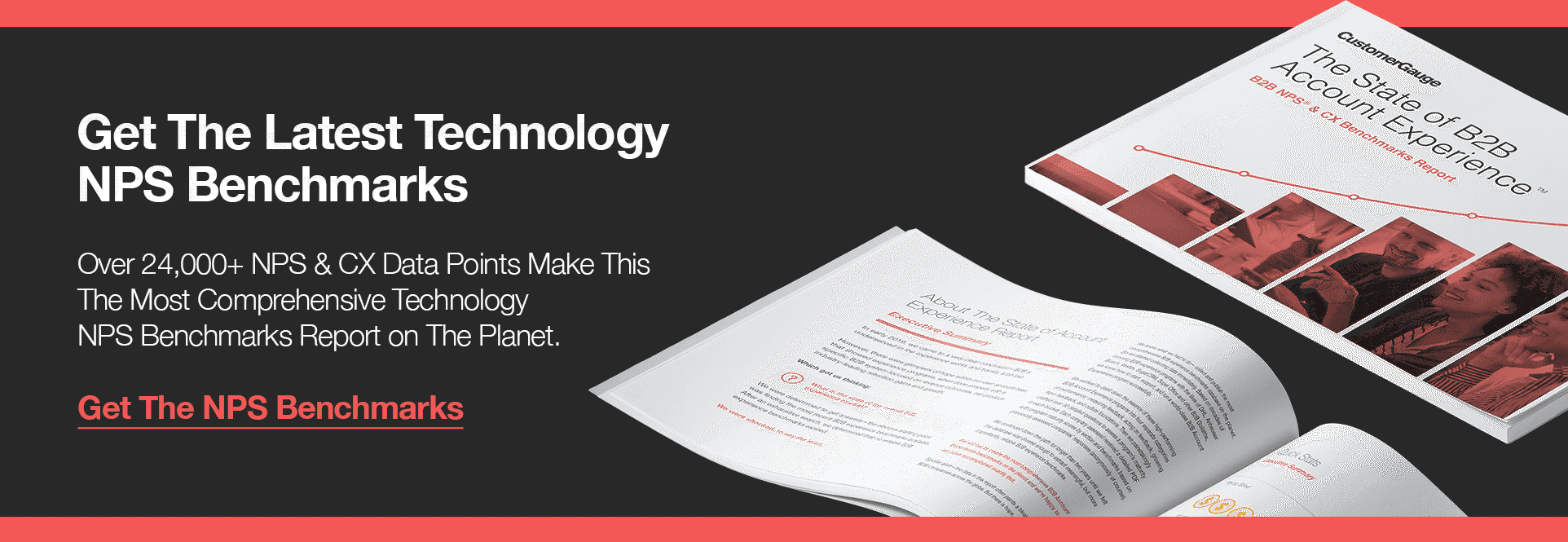
What is a Net Promoter Score (NPS) in SaaS?
Net Promoter Score (NPS) is a metric, developed by Fred Reicheld and Bain & Co, used to measure customer loyalty by asking how likely buyers are to become repeat customers or recommend products and services to their friends.
There is little significant variation in questions on SaaS NPS surveys. The wording is usually something along the lines of “How likely are you to recommend [product, service, company name] to a friend or colleague?”
Respondents always rate on a scale of 1-10, before being asked an open-ended follow-up question to determine deeper reasoning for their score. Sometimes, SaaS NPS questionnaires simply ask for an explanation of why respondents chose their score. Something like “What is the primary reason for your score?”. Other times, the wording is more specific.
Examples of alternative follow-up questions include:
What do you like most/least about [product, service, company name]?
How can we improve our service?
Which features do you value/use the most?
Which features do you value/use the least?
What features of [product, service, company name] did you value most/least?
Which of these features (x, y, z) contributed most to the score you gave?
Why is NPS Important for SaaS Companies?
NPS SaaS questionnaires are important because they help businesses to improve retention and referrals by optimizing the customer experience. Studies conducted by Harvard Business Review, Bain & Company, and CustomerGauge have identified a strong correlation between high NPS scores and revenue.
Read more about our methodology for tackling churn and earning more referrals from your Net Promoter Program.
Furthermore, our annual B2B NPS & CX Benchmarks Report identified that NPS still leads the pack as the most trusted metric in B2B at 41%, with CSAT (Customer Satisfaction) further back at 26%, and CES (Customer Effort Score) a distant fourth at 11%.
By examining their Net Promoter Score, SaaS companies can improve CX and customer service and grow their business more quickly by:
Identifying common issues for closer analysis.
Asking those who respond positively for online reviews or referrals.
Reaching out to address the problems flagged by negative responses before customers unsubscribe or leave negative reviews.
NPS in SaaS isn’t the be-all and end-all, though. Some critics argue that a single question is not a reliable marker and suggest that SaaS NPS Benchmarks are only helpful when combined with other metrics like in-app behavior to gain a more in-depth overview.
However, most companies already use a broad range of feedback metrics that provide detailed data when combined with an NPS score. SaaS-specific examples include:
Customer Lifetime Value (CLV)
Churn rate
Monthly recurring revenue (MRR)
MRR Growth rate
Renewal rate
Revenue retention
We are big believers in NPS as a successful growth driver and have written counter-arguments to almost all critiques of the Net Promoter System, check out our myth-buster article here.
However, we encourage NPS to be used together with these other metrics. If you can establish manageable processes for all CX measurements, then additional data can only add to your picture of customer account health.
Related Read: A Guide to Customer Retention in SaaS
How to Run an NPS Survey and Collect Data
Before you start collecting NPS data, be sure to check out the full range of CustomerGauge NPS resources, including field guides, tool kits, eBooks, podcasts, webinars, and whitepapers. Then follow these steps to create and activate your survey.
Decide which type of NPS survey to run. You can host an on-site survey on your website or create a stand-alone survey to be sent out in-app or via email.
Write your NPS questions and follow-up questions.
Ensure your survey has the best name and title description to encourage responses and help customers understand what you need.
Consider the visual elements carefully. Customers can be just as easily turned off by how the survey looks as by a poorly worded question.
Make sure your template includes a sign-off thanking respondents for their time.
Read these steps in-depth in our guide to NPS survey design.
When Should You Run an NPS Survey?
Editors note: Before we dive in, we have a full guide on best practice around 'when to send an NPS survey' here. We used our own customer data and discovered that NPS surveys should be run quarterly for the best results.
There’s no point sending an NPS survey before consumers have had a meaningful interaction with your product. Otherwise, how do they know enough to answer questions about future use or whether they’d recommend you?
The best time to run a survey is after the first significant customer milestone or ‘eureka moment’ because SaaS NPS surveys achieve more accurate responses when an experience is fresh in a customer’s memory. Many SaaS companies send NPS surveys right after the onboarding process because the first few payment cycles are crucial in pleasing and retaining new subscribers.
After that, there’s no right or wrong approach to frequency. But however badly you crave data, be wary of sending feedback requests too often. There’s nothing more off-putting to a customer than being continually spammed within the first few cycles of service.
SaaS NPS Benchmarks are a long-term measure of customer satisfaction. Many businesses send surveys bi-annually, we recommend doing them quarterly if your a B2B organization.
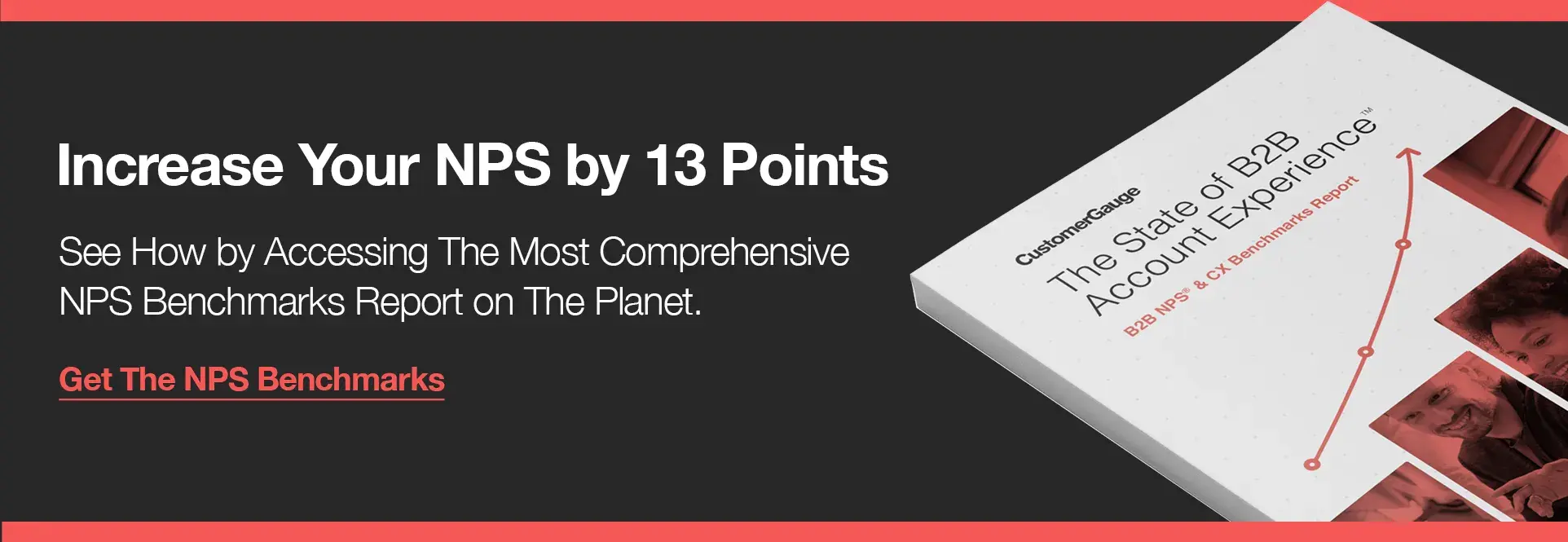
NPS Survey Best Practices
Designing an NPS survey needn’t be complex. When conducting NPS, SaaS companies can generate reliable data by following this list of best practices.
Keep it Short
We recommend a maximum of four or five questions, although our best results are based on surveys with just three. Any longer, and you’ll experience low response rates and inaccurate answers. Any shorter, and your data will have limited actionability.
Read more on this subject in our article 'why three questions is all it takes'.
Ask the Right Questions
How you phrase a question will allow you to focus on customer satisfaction while making the data you collect more specific to customer experiences. Take the following questions as examples:
How likely is it that you would recommend [product, service, company name] to your friends and family?
Based on your experience with [product, service, company name], how likely are you to recommend us to your friends and family?
Now you’ve been using [product, service] for [length of time], how likely are you to recommend [company name] to your friends and family?
See the difference?
Use Personalization
Customers are more likely to respond if you greet them by name and demonstrate a historical knowledge of their customer journey by mentioning specific features they’ve used or their trends over time.
Add a Comment Box
Adding a comment box conveys that you care about feedback beyond the scope of the survey. In our experience, 44% of survey respondents leave a comment. Be sure to clarify that additional comments are voluntary, so the survey doesn’t appear longer.
Build a Continuous Feedback Loop
Add a tick-box asking customers for permission to contact them to discuss their experience in more detail. You’ll get more feedback this way, plus it gives customers a voice and makes their opinion feel valued.
Send Reminders
Sending survey reminders is the best way to improve your response rate. You don’t want to hassle respondents too soon. However, if it’s a transactional survey, you don’t want to wait too long either. The standard waiting time for CustomerGauge clients is 3-7 days.
Avoid Spam Filters
Stay away from the following bad practices to avoid triggering spam filters when sending via email:
Using all-caps or exclamation marks in the subject line
Using too many different fonts, font sizes, and text colors
Including buzz phrases like ‘act now’ or ‘last chance.’
Test, Test, Test!
Testing an NPS survey will help you collect the most reliable data. Remember to ask for employee feedback on potential issues and any ideas for improvement. Sending internally first will ensure:
Your email engine is working
Emails open with the correct format and layout
Links to the survey work
The survey opens across different browsers and runs smoothly
How to Calculate NPS

Respondents are separated into three categories:
Promoters – Loyal enthusiasts that give ratings of 9 or 10
Passives – Indifferent customers giving scores of 7 or 8
Detractors – Dissatisfied customers who score between 0-6
To calculate your net promoter score, discount passive results and subtract the percentage of detractors from the percentage of promoters.
NPS SaaS ratings range between -100 (if all your respondents are detractors and +100 (when all your respondents are Promoters). However, neither scenario is likely, so let’s look at a more realistic equation. If 50% of respondents were Promoters and 10% were Detractors, your net promoter score would be 40.
So, what is a good NPS score for SaaS products? In the SaaS industry, where the average score is +36, a score greater than 36 would be considered good, but our customers typically achieve 50% higher than this and it should be your ultimate goal to match leading players in the industry.
It’s good to be aware of the leading NPS Benchmarks for SaaS companies, because this tells you how much work is required to keep up with leaders in your industry.
Net Promoter Score Scale: Promoters
The goal is to attract and retain as many promoters as possible, as these are the customers who refer others, thus fueling business growth. Because they’re already advocates, promoters are usually happy to hear from you. After every survey, contact promoters with:
A message of thanks for their input
Instructions on how to refer friends and family
Requests to leave online reviews
Directions to share their experience on social media channels
Net Promoter Score Scale: Detractors
Research shows that 95% of customers will give you a second chance if you handle their complaints quickly and successfully. NPS surveys are a great way of identifying unhappy customers so you can reach out and turn them into promoters before they can slow your growth through negative word of mouth and online reviews. The solution may be as simple as providing additional education on using your services, or fixing a bug or service issue.
Net Promoter Score Scale: Passives
Reaching out to passive respondents is your best chance of reducing churn rates, as unenthusiastic customers can become easily tempted by competitor offers. Passive respondents are on the fence, so this is your opportunity to impress them, earn their loyalty, and work towards your SaaS NPS Benchmark goal by turning them into a promoter. You can do this by:
Addressing their specific comments directly
Providing education on product features they missed
Instructing them on how to navigate and use your services better
Detailing upcoming improvements and updates that will better meet their needs
How to Analyze Net Promoter Score Results
Calculating your NPS score can seem daunting if you’re sending out surveys to a large customer base. That’s why we created this simple NPS calculator in Google Sheets for you to download and use. When it comes to analyzing your open response data, these are the best practices to follow.
Categorize - By organizing feedback into topics, you can contextualize the areas most in need of improvement. Examples include customer service, functionality, and navigation.
Use Demographics – Separating responses into groups based on location, age, gender, income, etc., helps you better understand your promoters and detractors. You can use this data to provide more customized experiences by targeting updates and specific feature developments towards particular segments.
Record Sentiments – By tagging comments as positive, negative, or neutral, you can learn more about potential shifts between promoters, detractors, and passives, and be proactive in steering customers in the right direction.
Measure Changes – Compare the findings of each survey. Did the changes you implemented based on your last NPS SaaS questionnaire pay off? And if not, why not?
What's the SaaS Industry average NPS score?
In our latest NPS Benchmarks Report, we discovered that the average NPS score for the SaaS industry is +36. While positive, a score of +36 still has room for improvement compared to other industries like healthcare, consumer brands, and CPG.
As industries continue to digitize, software companies will continue to grow. New demands for cyber-security and privacy–especially in light of big data–will require providers and companies to keep up with the specific needs of clients. And growing capabilities due to 5G, artificial intelligence, and low-code or no-code tools will provide new efficiencies and space for innovation.
To continue offering exceptional service and support, software companies can use systems tailored to maximizing the return on their Account Experience.
Collecting and acting on feedback from accounts on an ongoing basis can not only help increase their net revenue retention rates, but increase valuations.
Learn how we collected and measured NPS benchmark data for the SaaS industry in the full report linked above, and discover more NPS score rankings for other industries in our guides to finance & banking, insurance and telecoms.
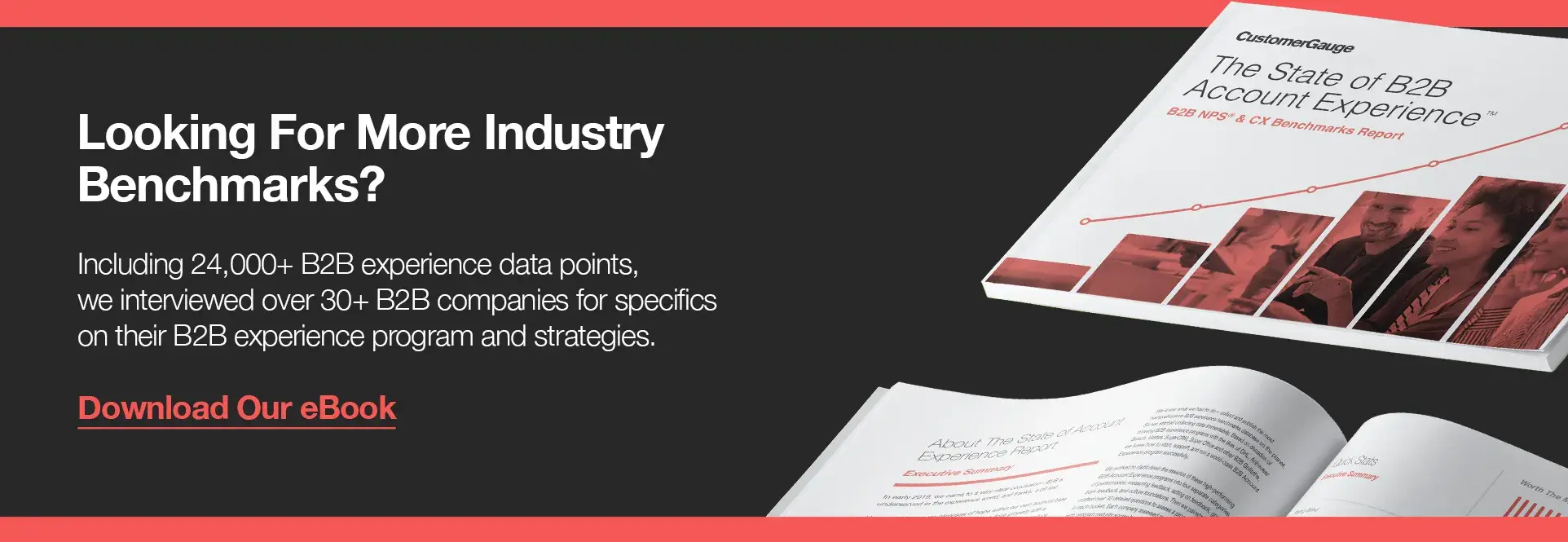
What's a good NPS score for SaaS?
Bain & Company (the creators of NPS) note that a good NPS score is 0 and above. Above 50 is excellent and above 80 is world class.
A score that's zero and above suggests that you have more Promoters than Detractors, which is a good sign. However, it's important to compare yourself to others in your industry.
In the SaaS industry, where the average score is +36, a score greater than 36 would be considered good, but our customers typically achieve 50% higher than this and it should be your ultimate goal to match leading players in the industry.
Remember, your business goal should not be to get more people to buy from you, but to get more people to refer you.
Read more in our article ‘what is a good NPS score?’
Top SaaS NPS scores: 38 NPS Benchmarks for SaaS Companies
Leading (large players) SaaS NPS scores
Want to know NPS scores for all major industries with tips to improve your score? Get the most comprehensive B2B NPS benchmarks guide on the planet here.
Three SaaS Companies Using NPS
To gain a broader understanding of the importance of NPS for SaaS companies, let’s take a look at a few industry leaders and determine how they are using NPS strategies to improve customer loyalty and drive growth.
PandaDoc
PandaDoc is an electronic document creation and e-signature tool. The company has 600+ employees and serves over 30,000 customers. PandaDoc's Net Promoter Score is 49, which is above the SaaS industry average NPS. Responders comprise 66% promoters, 17% passives, and 17% detractors.
What’s the PandaDoc Difference? Plenty, actually:
The PandaDoc CX team integrates NPS feedback directly into the company-wide slack channel to keep customer experience at the forefront of operations.
The team has identified “success KPIs” like how long it takes for customers to build templates, document expiration rates, close rates, and rejection rates. These are tracked on a customer level inside the app to determine where improvements are needed.
Every six months, 10-20 customers are invited to an advisory board meet-up to discuss the product road map, CX strategy, and share insights.
Google's Net Promoter Score is 50, comprising 67% promoters, 16% passives, and 17% detractors. While this is above average for a SaaS NPS Benchmark, it’s only enough to rank 9th in the list of Global Best Brands. However, the search engine is ranked 3rd for Top Brands for Millennials and 1st for Top Brands for Gen Z.
This tells us something about the demographic the Google team is chasing, and how they use NPS surveys to tweak their approach and reach their target segments. Forbes reports that 52% of all online consumers consider a company’s values. That rate is even higher among the Millennial and Gen Z generations. Google has increased its NPS SaaS rating and achieved growth by focusing on the needs and desires of Millennial and Gen Z generations. How? By offering services that add value to that demographic - like live chat troubleshooting in real-time with requests answered in under 30 seconds.
Slack
Slack attracts 12 million active daily users, and 156,000 organizations subscribe to Slack services. Slack's Net Promoter Score is 57, comprising 69% promoters, 19% passives, and 12% detractors. Again, well above the average NPS in SaaS. Slack has made a name for itself by continually increasing its year-on-year revenue, with income skyrocketing by a staggering 43% between 2020 and 2021.
So what strategy did Slack use to achieve this? Using NPS results to identify the top reasons people recommend their services or not, the company developed a philosophy based on referrals. At Slack, the primary metrics are not new sign-ups, revenue, satisfaction, or dissatisfaction. The bar is set at whether existing users recommend it or not.
Top 3 Best SaaS eNPS scores
In a previous blog, we introduced the employee Net Promoter Score (eNPS) as a metric designed to gauge employee loyalty. We covered the risks and costs associated with employee churn, as well as the benefits of having a positive score.
In this section, we'll look at three software companies with strong employee Net Promoter Scores according to employee responses on Comparably and other resources. We’ll then determine how each company achieved their status through forward-thinking strategies targeted at enhancing employee experience and engagement. Read on to see what makes Adobe, HubSpot, and Salesforce stand out from other ve made a difference in their business.
HubSpot, eNPS = 91
Since its start-up days, HubSpot placed a lot of emphasis on cultivating the right culture according to its values.
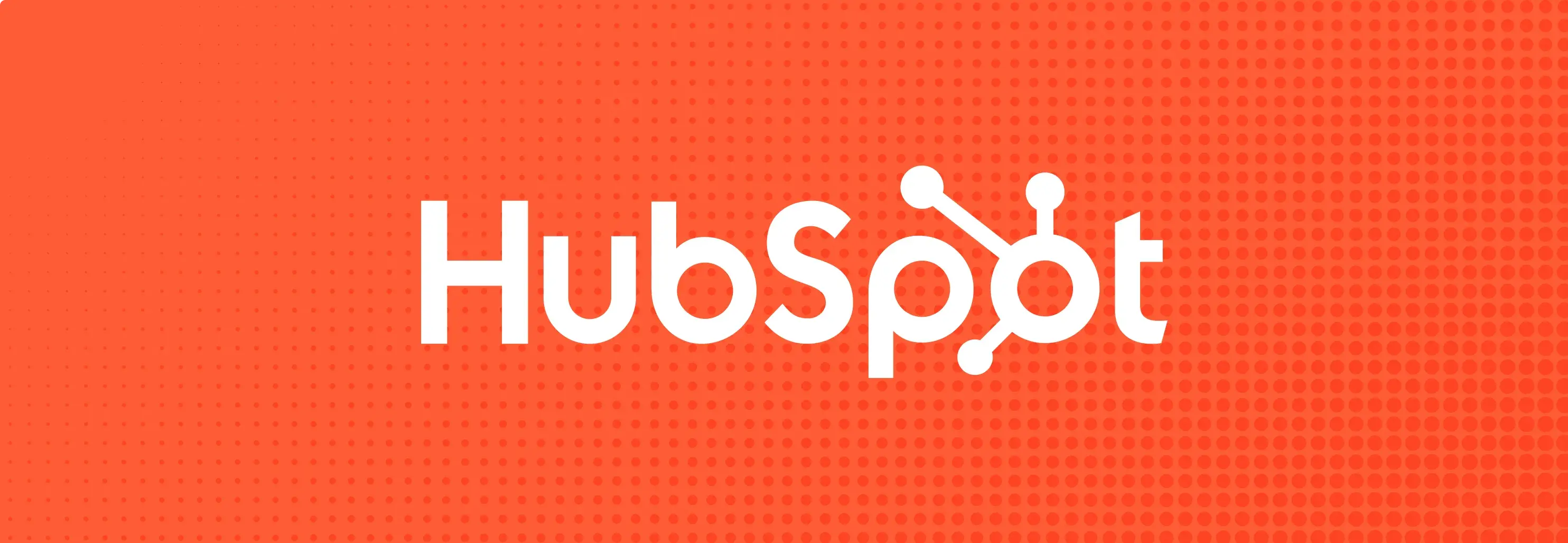
However, HubSpot’s employee experience weathered a few controversies and attacks in recent years. In 2016, the firm was singled out for its mediocre diversity ranking—89% of the company’s employees were under the age of 35, while 85% were white.
In response to the allegations, HubSpot’s Chief People Officer, Katie Burke, boldly published the company’s 2016 Diversity Data, along with a transparent plan of what HubSpot planned to do to rectify their previous grievances and the progress they’ve had so far.
During an interview with TechTarget in February, 2018, Burke commented that she was proud of HubSpot for “owning the experience.” The company acknowledged the areas it wanted to improve, then tackled the issue head-on. In just over a year, HubSpot redefined its employee hiring process, addressed minority group needs, and established multiple initiatives to support women in the company.
“Inclusion is how welcoming your employee base and employee experience feels to all of your employees. And so, what we use on a regular basis is our employee Net Promoter Score survey, which gives us a lot of really valuable feedback on pockets of the organization where we hope to improve...”
By using the employee Net Promoter System®, HubSpot distinguished the needs of different employees and established appropriate strategies in order to meet them. Today, HubSpot hosts a variety of Employee Resource Groups designed promote community and inclusivity throughout the company. Completely employee-run, the groups help promote safe, open environments that embrace personal and professional growth.
The company’s latest diversity data has shown significant improvement—41% of all HubSpot employees are now female. What’s more, there are now 133 (45% total) women in leadership roles—almost double the number in 2016. HubSpot also saw a 3% increase in the number of minority-identifying employees working in technical roles.
The changes didn’t go unnoticed. Just this year, HubSpot ranked No. 15 in the Best Workplace for Millennials list according to Fortune. The company now receives employee feedback on a quarterly basis, noting that annual surveys aren’t frequent enough to make necessary changes.
With an eNPS of 91, the the company outranks its competitors by a wide margin. With a new, inclusive mindset and passion for continuous improvement, HubSpot raised the bar for employee experience.
Salesforce, eNPS = 58
Beyond being spotlighted as an NPS champion on our most recent benchmarks report, Salesforce—a customer relationship management software business—has been regularly lauded for its forward-thinking corporate culture and environment. In 2017, the company was No. 1 on Fortune’s annual list of 100 Best Companies to Work For. At the heart of Salesforce’s success with employee experience are technological innovation and an employee-centric approach.

Solving for Employees
From the start of her Salesforce career as the Head of Competitive Marketing, Jody Kohner, now Senior VP of Employee Marketing & Engagement, noticed the passion and dedication that Salesforce employees exuded. Their spirit and enthusiasm even impacted customer acquisition—prospects would often convert to customers after meeting and interacting with Salesforce employees.
“Coming from a marketing background, the first thing I asked was: ‘Who is my customer?’ The answer was my Salesforce employees. My next question was: ‘How can I build a great experience for them at every stage of their journey?’”
Kohner understood that in order to nurture great employee experience, she needed to solve for the unique needs of each employee group. For example, a new employee needed a different experience from someone who has been with Salesforce for 15 years. Her strategy involved identifying needs at every stage of the full employee life cycle. In turn, this process influenced the kinds of programs and solutions she would later implement to solve for end-user needs.
In an effort to promote gender equality, Salesforce initiated a program to eliminate the wage gap. To date, the company spent $6 million to ensure that every employee was compensated fairly.
Using Technology to Enhance Employee Experience
In just 5 years, Salesforce expanded its workforce from 13,000 people to 32,000. On-boarding thousands of new hires each year provided multiple challenges for the company as it needed to adjust its operational, cultural, and technological capabilities.
The IT team stepped up to the challenge of rethinking EX. At the time, employees struggled to find the information they needed on the company’s internal platform, leaving the IT department overwhelmed with tickets. The solution was to introduce a few apps that would replace the company’s intranet. After a successful application, the self-service apps answered 95% of employee needs in real-time.
In an interview with HBR, Jody Kohner comments:
“Today’s employees want social, mobile, intelligent, and connected technologies—the same as the ones they are using outside of work.”
The company established a worldwide practice of data transparency. The idea originated from a desire to measure success and progress in a way that would motivate employees and encourage collaborative problem-solving at an inter-departmental level. The system was called V2MOM, or Vision, Values, Methods, Obstacles and Metrics.
V2MOM is updated by the CEO and executive management every year and helps develop quarterly goals for all departments and employees. What’s more, the platform is public, meaning that every employee has access to the goals and progress of any department.
Salesforce uses a similar approach for monitoring employee engagement. The company sends out employee satisfaction surveys twice a year and publishes the results in a company app. Just like V2MOM, the results are transparent. The formal approach to evaluating and measuring engagement helps managers keep employee experience at the forefront of their duties. What’s more, every department is responsible for establishing goals and KPIs to improve even further.
Today, the average employee tenure at Salesforce is 3.3 years—on the higher end of the industry average for Silicon Valley employees at SaaS companies.
Today, Salesforce is valued at $3.3 billion. The company impressively beat its revenue-growth expectations for 12 consecutive quarters and aspires reach more milestones in the future. With a goal of $20 billion in revenue by fiscal year 2022, Salesforce is off to a great start by leveraging its workforce to become its greatest advocates.
Adobe, eNPS = 57
It should be no surprise that Adobe—the company that developed the PDF format and brought us game-changing software like Photoshop—is as serious about its employee experience as it is about its product.
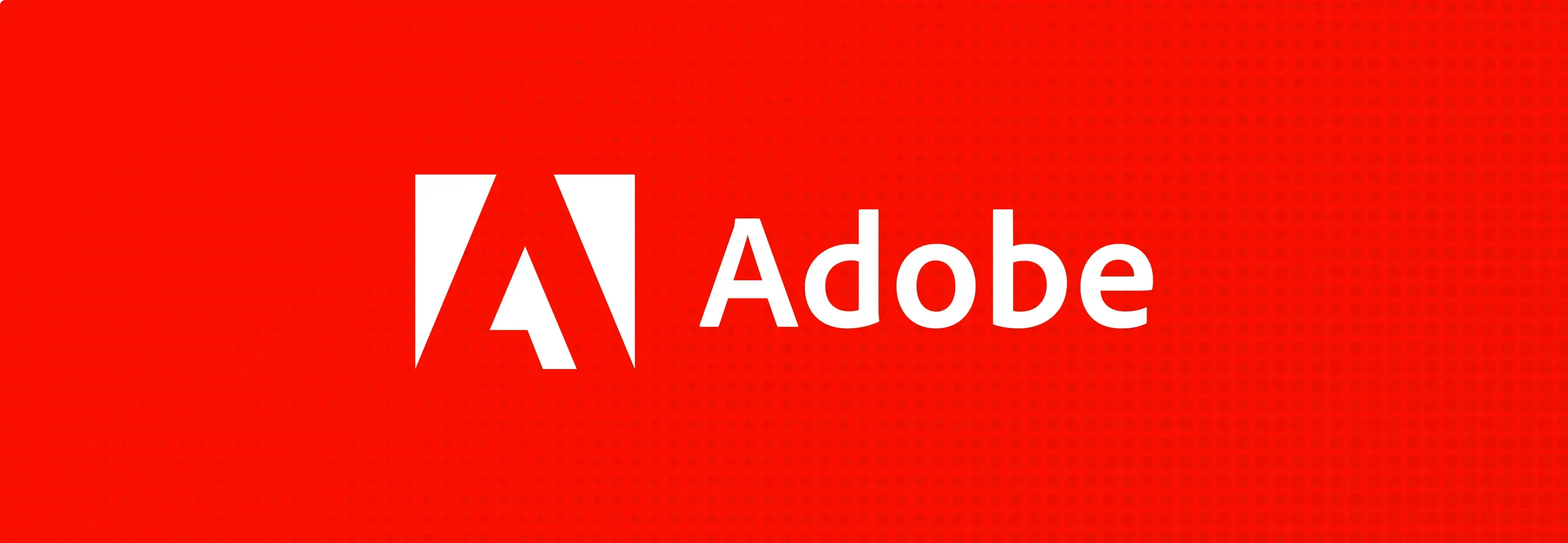
Adobe was an early adopter of eNPS and has been making advances in their culture ever since. Their key to success? Give employees the same treatment the company gives its customers.
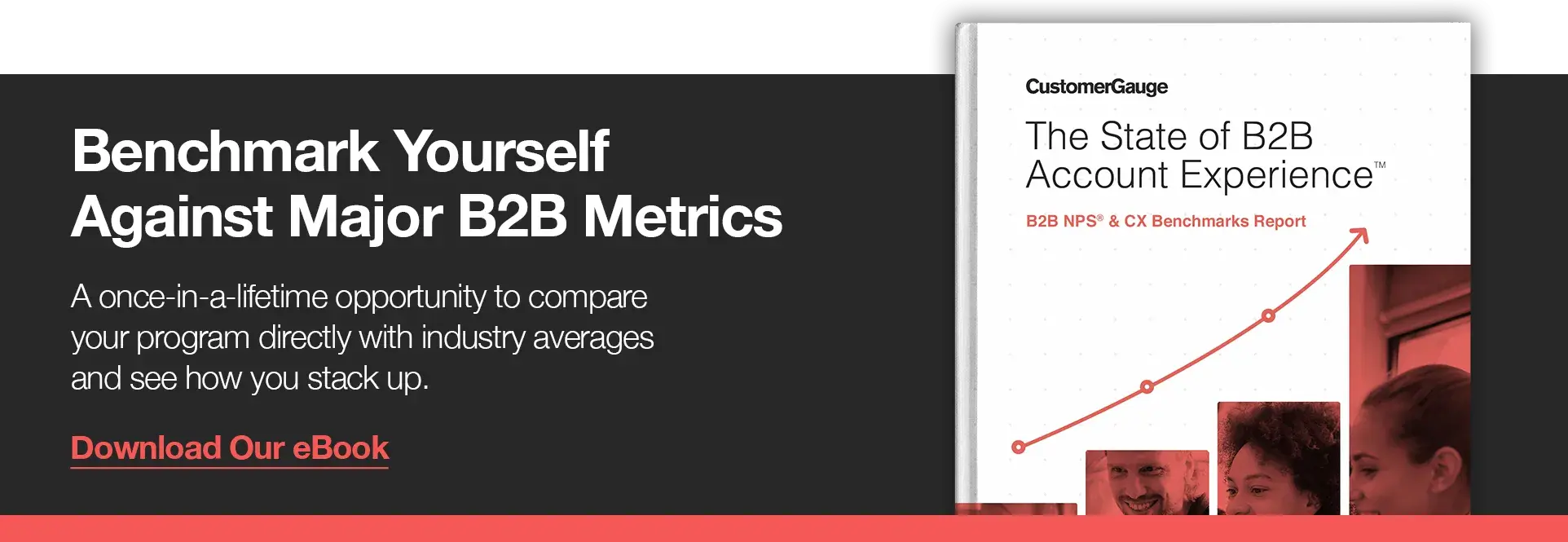
Mapping the Employee Journey and Establishing Personas
When Adobe’s CIO, Cynthia Stoddard, joined the company 2 years ago, she saw the value in strengthening employee retention by building up experience. “When you think about our offerings across Creative Cloud, Document Cloud, and Experience Cloud, Adobe is offering a phenomenal digital experience to customers,” she writes in the Adobe company blog.
“I wanted to make sure we were bringing those insights and the same world-class experience to our internal customers—our employees—because happy employees naturally lead to happier customers.”
To do so, Cynthia aimed to match Adobe’s work environment with the “personalized and design led” experiences her employees were accustomed to in everyday life. She mapped her employee journey and established unique employee personas: Builder, Enabler, Customer-facing and Communicator.
Then, she tailored the working environment to match each persona. For example, a Builder’s objective is to create effective UX in their software, meaning that his resources would be different from that of a Communicator.
By optimizing the opportunities, tools, and digital environment of each persona, Cynthia’s employee experience IT group was able to minimize work complexity and solve for her workforce’s unique needs.
Creating a Constructive Working Environment
At Adobe, employee experience covers everything from office infrastructure to premium, competitive benefits.
Adobe HQ. In 2016, Adobe opened the doors to its new, cutting-edge HQ compound in San Jose. It wasn’t just a matter of space. The company was eager to reflect their present-day values, culture and workforce through the design and atmosphere of their main offices. Complete with multiple work floors, the new 162,600 sqft space also comprises a Customer Experience Center, Wellness Center, as well as new cafes and lobbies. By providing a collaborative, easy-to-work-in space, Adobe put the end users—their employees—first. And the best part? The HQ never runs out of free food!
Benefits that make a difference. Adobe understands the importance of work-life balance for employees, and its generous package matches that promise. The company has 18 paid holiday days in 2018 and has planned 19 more for 2019. In addition, most employees are offered unlimited vacation time based on department approval. The company offers sabbaticals along with leaves of absence for medical, personal, family, parental, and military purposes. The company’s superior maternity leave and flexible, family-friendly culture earned Adobe a spot on the Working Mother Magazine’s Best Company list.
Adobe holds its employees in high regard, and the respect goes both ways. The company’s average employee tenure is 5.3 years. This kind of retention beats companies like Facebook (2.02 years), Google, (1.90 years) and Microsoft (1.81 years). Adobe is an excellent example of how loyalty can impact employee retention.
SaaS NPS Trends Over Time
For a detailed analysis of B2B account experience, we recommend you download our NPS& CX Benchmarks Report. In the meantime, remember that regardless of how you manage your NPS, SaaS companies will always need to consider a few extraneous variables that affect trends over time.
Non-SaaS Comparisons
Non-SaaS businesses typically achieve higher NPS ratings because SaaS is a lower tolerance industry with low entry and exit barriers where vendor switching is easy. So there’s little point comparing your NPS results with sectors outside of your niche. For example, it’s relatively straightforward for a customer to switch from one streaming provider to another, whereas switching their car brand would be more complex – and likely incur financial penalties.
Competition
The more competition you have in your niche, the better an indicator of success your NPS score will provide. So as more SaaS products and apps emerge, more effort will be needed to maintain customer satisfaction scores. To put this in context, Tesla has an NPS score of 97. However, this is primarily attributed to the company’s unique market position. Customers have very few alternative choices and are therefore more satisfied.
Global Events
While events of global significance are rare, they have a notable impact on NPS Scores. For example, during the COVID-19 pandemic, the general dissatisfaction with the ‘new normal’ led to NPS ratings dropping by 15.2 points, with younger people giving the lowest scores.
What it means to Monetize your NPS score
We promised we would get to it, and here we are: what it means to monetize your NPS score in SaaS.
I recommend downloading our whitepaper eBook on AccountExperience. It’s this methodology that sets CustomerGauge apart from the rest, and it’s this methodology that earned us the #1 ranking by Gartner for B2B voice of customer platforms.
In summarize the eBook, monetized net promoter is the process of operationalizing NPS survey feedback so that you can:
- Identify which of your accounts are about to churn. E.g. receiving advice like ‘based on your recent survey round $1.6m in revenue is at-risk of churn. This includes your largest account with an ARR of $1m.’
- Identify which of your accounts are willing to refer you. E.g. receiving advice like ‘your customer, XYZ Corp, has given you a score of 9 or 10. It’s time to ask them for that referral.’
- Identify which of your accounts are likely upsell opportunities. E.g receiving advice like ‘users at all levels of XYZ Corp’s organisation are extremely happy with your service. Your next review meeting is a good chance to focus on what’s next.’
A monetized net promoter and AccountExperience are the next step: operationalizing feedback.
Many companies measure NPS but fail to act upon it. To act, you need to listen to each piece of feedback and develop a process to close the loop on it. Either you talk to your unhappy customers, apologize and fix their issue. Or you talk to your happy customers, celebrate together and ask for referrals.
AccountExperience is the methodology that helps you shift from ‘NPS is a research tool’ to ‘NPS is a growth driving tool’.
Related Read: Why AccountExperience is the next big thing in SaaS
Blog Home





